Search
- Page Path
-
- HOME
- Search
- Review Article
- Demographic transition in South Korea: implications of falling birth rates
- Chae Young Kim, Sung-Hoon Chung
-
This review examines the critical issues of declining total fertility rates (TFRs) and aging populations in East Asia with special focus on South Korea. It provides a comprehensive analysis of TFR trends, aging demographics, and the policy responses of these nations to the low-fertility crisis. This study highlights the intricate tapestry of the factors contributing to these demographic shifts, including... -
DOI: https://doi.org/10.3345/cep.2023.01599 [Accepted]
- Infection
- Epidemiological changes in infectious diseases during the coronavirus disease 2019 pandemic in Korea: a systematic review
- Jong Gyun Ahn
- Clin Exp Pediatr. 2022;65(4):167-171. Published online November 30, 2021
-
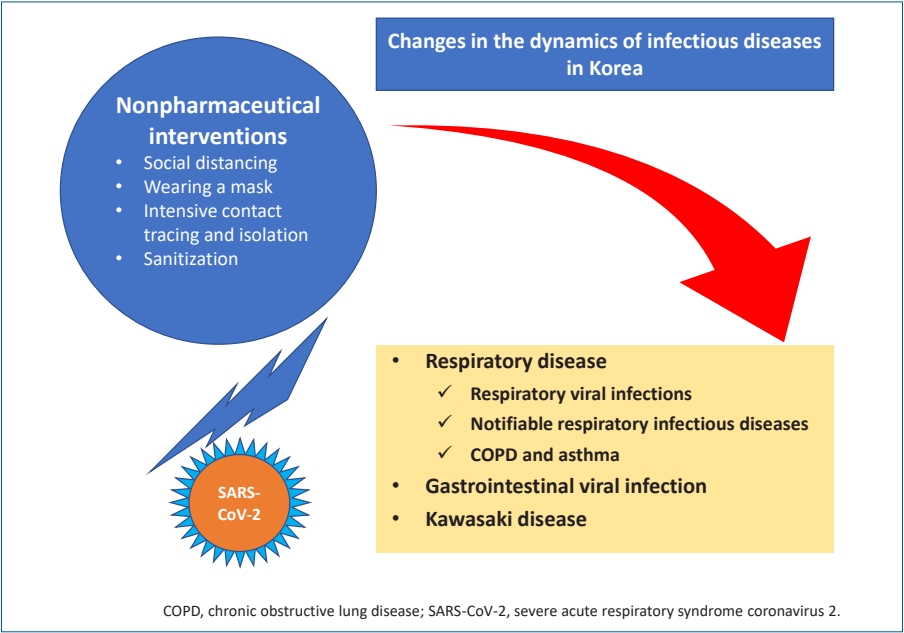
· Nonpharmaceutical interventions (NPIs) have had a major impact on the epidemiology of various infectious diseases in Korea.
· Respiratory diseases and gastrointestinal viral diseases were significantly reduced during the NPI period.
· The decrease in Kawasaki disease after the introduction of NPI is an unintended result.
· Infectious diseases that decreased during NPI use may re-emerge.
· We must continuously monitor the epidemiology of various infectious diseases during the coronavirus era
- Changes in age-specific seroprevalence of Japanese encephalitis virus and impact of Japanese encephalitis vaccine in Korea
- Byung Ok Kwak, Young Jin Hong, Dong Hyun Kim
- Clin Exp Pediatr. 2022;65(3):108-114. Published online September 24, 2021
-

Since the introduction of a universal Japanese encephalitis (JE) vaccination program and urbanization, the incidence of JE has dramatically decreased in Korea. However, recent JE cases have occurred, predominantly among unvaccinated adults and with a shift in age distribution. Continuous surveillance of the seroprevalence of JE is required to establish a proper immunization policy in Korea.
- Nutrition
- Changes in health status of North Korean children and emerging health challenges of North Korean refugee children
- Seong-Woo Choi
- Clin Exp Pediatr. 2021;64(11):552-558. Published online May 17, 2021
-
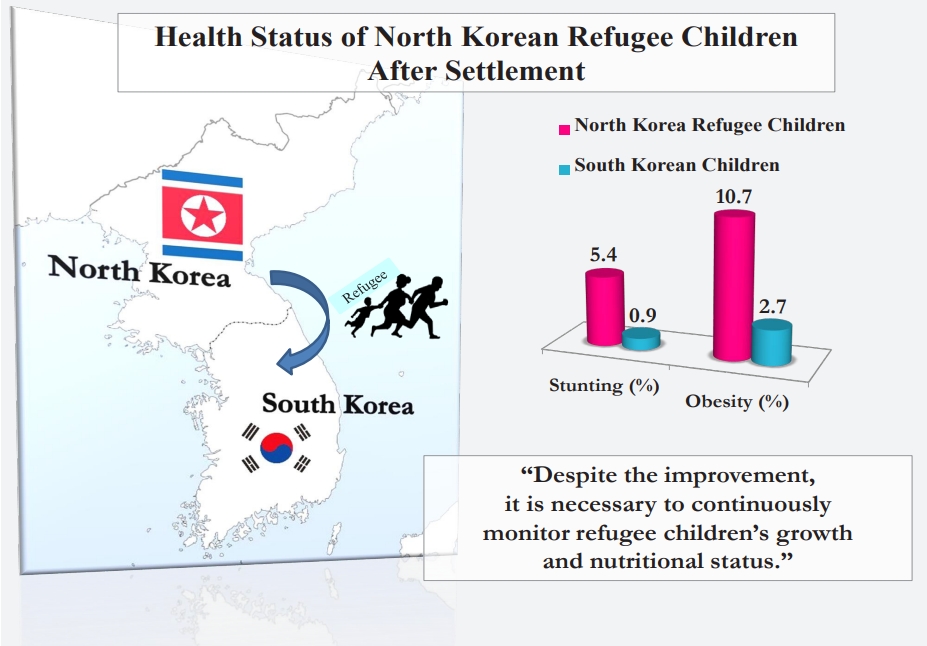
· Among North Korean refugee (NKR) children under 5 years, 61% and 9.3% were underweight in 1998 and 2017, respectively.
· The immunization rate of NKR children exceeded 90% since 2006.
· For NKR children, protein-energy malnutrition was the #1 cause of death in 2009 versus #17 in 2019.
· In 2020, stunting affected 5.4% and 0.9% and obesity affected 10.7% and 2.7% of NKR versus South Korean children, respectively.
- Guideline
- Endocrinology
- 2017 Clinical practice guidelines for dyslipidemia of Korean children and adolescents
- Jung Sub Lim, Eun Young Kim, Jae Hyun Kim, Jae-Ho Yoo, Kyung Hee Yi, Hyun Wook Chae, Jin-Ho Choi, Ji Young Kim, Il Tae Hwang; the Committee of Dyslipidemia of Korean Children and Adolescents on behalf of Korean Society of Pediatric Endocrinology (KSPE)
- Clin Exp Pediatr. 2020;63(12):454-462. Published online November 25, 2020
-

Question: How are children and adolescents with dyslipidemia treated and managed in Korea?
Finding: 2017 guidelines recommend to measure nonfasting non-HDL-C as a screening test and introduce new diet methods: Cardiovascular Health Integrated Lifestyle Diet (CHILD)-1, CHILD-2-low-density lipoprotein cholesterol, and CHILD-2-triglyceride. Statin is the only drug approved in children older than 10 years.
Meaning: New clinical practice guidelines for treating and managing dyslipidemia of Korean children and adolescents are provided.
- Review Article
- Gastroenterology
- Causes of acute gastroenteritis in Korean children between 2004 and 2019
- Eell Ryoo
- Clin Exp Pediatr. 2021;64(6):260-268. Published online September 18, 2020
-

· Norovirus is the most common virus in Korean children with acute gastroenteritis.
· Escherichia coli and Salmonella spp. are the most common cause of bacterial gastroenteritis in Korean children, with a detection rate of 3%–20%.
· Uncommon bacterial and parasitic gastroenteritis require attention because of increasing international exchange and overseas travel.
- Original Article
- Developmental and Behavioral Medicine
- Development of the Korean Developmental Screening Test for Infants and Children (K-DST)
- Hee Jung Chung, Donghwa Yang, Gun-Ha Kim, Sung Koo Kim, Seoung Woo Kim, Young Key Kim, Young Ah Kim, Joon Sik Kim, Jin Kyung Kim, Cheongtag Kim, In-Kyung Sung, Son Moon Shin, Kyung Ja Oh, Hee-Jeong Yoo, Hee Joon Yu, Seoung-Joon Lim, Jeehun Lee, Hae-Ik Jeong, Jieun Choi, Jeong-Yi Kwon, Baik-Lin Eun
- Clin Exp Pediatr. 2020;63(11):438-446. Published online May 14, 2020
-
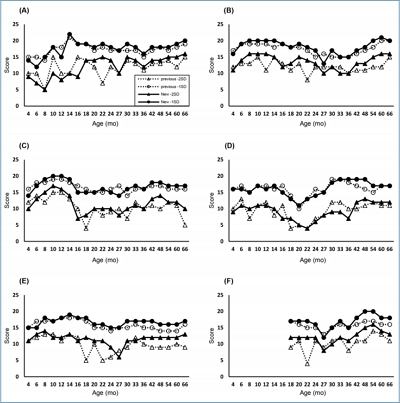
Question: Can the Korean Developmental Screening Test for Infants and Children (K-DST) be a useful screening tool for infants and children in Korea?
Finding: The K-DST has high reliability (internal consistency of 0.73–0.93, test-retest reliability of 0.77–0.88) and a high discriminatory ability with a sensitivity of 0.833 and specificity of 0.979.
Meaning: The K-DST is an effective and reliable screening tool for infants and children with neurodevelopmental disorders in Korea.
- Allergy
- Ten-year trends and prevalence of asthma, allergic rhinitis, and atopic dermatitis among the Korean population, 2008–2017
- Jihyun Ha, Seung Won Lee, Dong Keon Yon
- Clin Exp Pediatr. 2020;63(7):278-283. Published online January 29, 2020
-
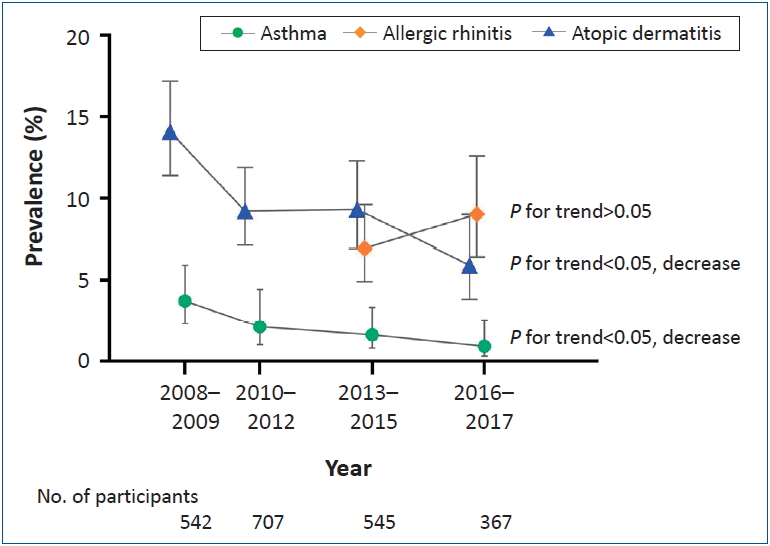
Background: Major questions remain regarding the agestratified trends of allergic diseases and asthma in Korea.
Purpose: To identify the estimated recent prevalence and 10- year trends in asthma, allergic rhinitis, and atopic dermatitis among the Korean population from 2008 to 2017. Methods: This nationwide cross-sectional survey (Korean National Health and Nutrition Examination Survey) over 10 years (2008–2017) examined representative samples of the...
- Review Article
- Recommended immunization schedule for children and adolescents: Committee on Infectious Diseases of the Korean Pediatric Society, 2018
- Eun Hwa Choi, Su Eun Park, Yae-Jean Kim, Dae Sun Jo, Yun-Kyung Kim, Byung-Wook Eun, Taek-Jin Lee, Jina Lee, Hyunju Lee, Ki Hwan Kim, Hye-Kyung Cho, Eun Young Cho, Jong-Hyun Kim
- Clin Exp Pediatr. 2019;62(7):252-256. Published online July 15, 2019
-
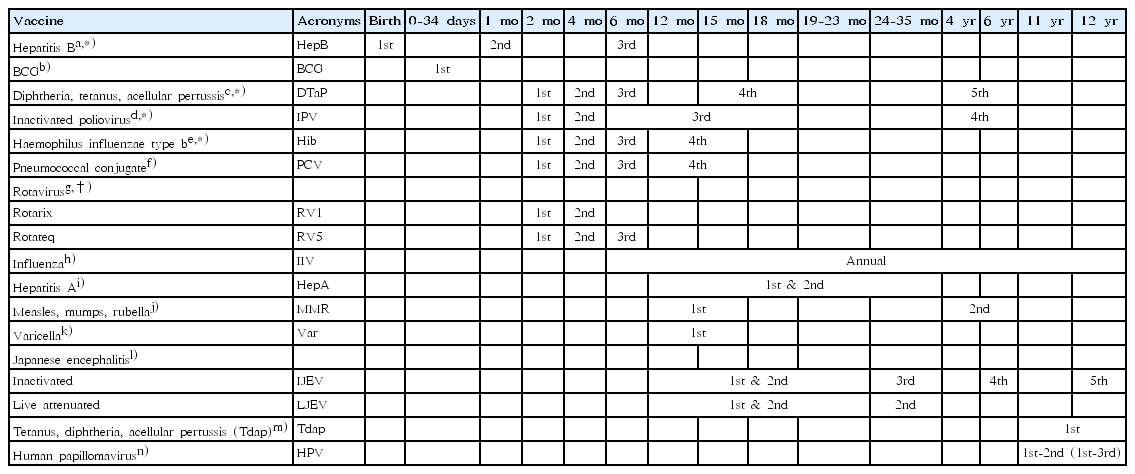
The Committee on Infectious Diseases of the Korean Pediatric Society recommended immunization schedule for children and adolescents aged 18 years or younger in the 9th (2018) edition of Immunization guideline. This report provides the revised recommendations made by the committee and summarizes several changes from the 2015 guideline. National immunization program (NIP) launched a human papillomavirus (HPV) immunization for girls...
- Original Article
- Developmental and Behavioral Medicine
- Validity of the Korean Developmental Screening Test for very-low-birth-weight infants
- Chae Young Kim, Euiseok Jung, Byong Sop Lee, Ki-Soo Kim, Ellen Ai-Rhan Kim
- Clin Exp Pediatr. 2019;62(5):187-192. Published online March 20, 2019
-

Purpose: The importance of the neurodevelopmental outcomes of very-low-birth-weight (VLBW) infants has been emphasized as their mortality rate has markedly improved. This study aimed to assess the validity of the Korean Developmental Screening Test (K-DST), a developmental screening tool approved by the Korean Society of Pediatrics, for the timely diagnosis of neurodevelopmental delay in VLBW infants. Methods: Subjects included VLBW infants...
- Other
- Rapidly growing pediatric trampoline-related injuries in Korea: a 10-year single center retrospective study
- Min Jeng Cho, Jihoon Kim, Sung Jeep Kim, Kyu Hyouck Kyoung, Min Ae Keum, Sung Kyun Park
- Clin Exp Pediatr. 2019;62(3):90-94. Published online March 11, 2019
-
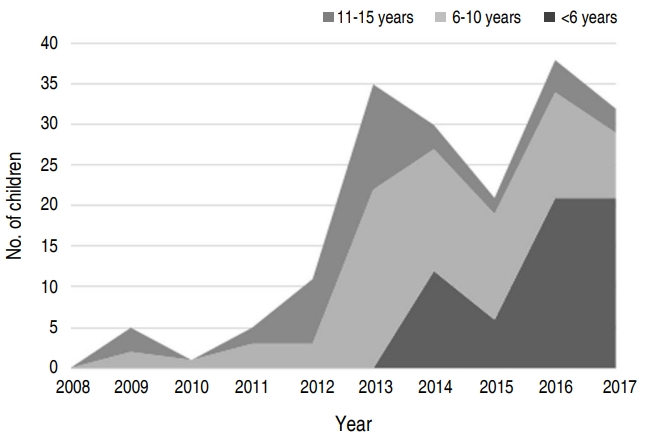
Purpose: Several published policy statements have warned against the risks associated with trampoline use and recommended safety guidelines. However, few studies have focused on trampoline-related injuries in Korea. This study aimed to assess the incidence and characteristics of pediatric trampoline-related injuries presented to Ulsan University Hospital. Methods: We retrospectively reviewed the medical records of children aged <16 years with trampoline-related injuries...
- Endocrinology
- Final height of Korean patients with early treated congenital hypothyroidism
- Jiyun Lee, Jeongho Lee, Dong Hwan Lee
- Clin Exp Pediatr. 2018;61(7):221-225. Published online July 15, 2018
-
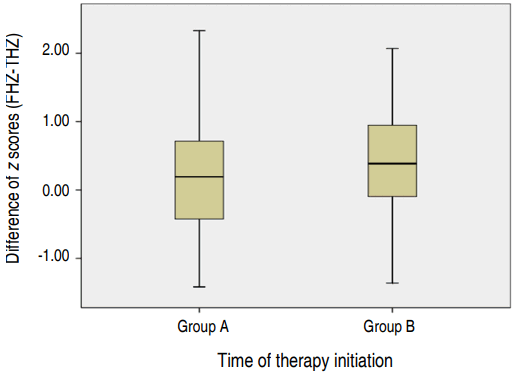
Purpose: Congenital hypothyroidism (CH) is the most common endocrine disorder in children. Thyroid hormone deprivation results not only in mental retardation but also growth retardation. This study investigates the final height (FH) in Korean patients with CH detected by newborn screening and examines factors that may affect the FH. Methods: The medical records of Korean CH patients (n=45) were reviewed. The...
- Review Article
- General Pediatrics
- The 2017 Korean National Growth Charts for children and adolescents: development, improvement, and prospects
- Jae Hyun Kim, Sungha Yun, Seung-sik Hwang, Jung Ok Shim, Hyun Wook Chae, Yeoun Joo Lee, Ji Hyuk Lee, Soon Chul Kim, Dohee Lim, Sei Won Yang, Kyungwon Oh, Jin Soo Moon; for the Committee for the Development of Growth Standards for Korean Children and Adolescents, the Committee for School Health and Public Health Statistics; the Committee for School Health and Public Health Statistics; the Korean Pediatric Society, and Division of Health and Nutrition Survey; Korea Centers for Disease Control and Prevention
- Clin Exp Pediatr. 2018;61(5):135-149. Published online May 28, 2018
-

Growth charts are curves or tables that facilitate the visualization of anthropometric parameters, and are widely used as an important indicator when evaluating the growth status of children and adolescents. The latest version of the Korean National Growth Charts released in 2007 has raised concerns regarding the inclusion of data from both breastfed and formula-fed infants, higher body mass index...
- Original Article
- Cardiology
- A comparative study of established
z score models for coronary artery diameters in 181 healthy Korean children - Kyungguk Ryu, Jeong Jin Yu, Hyun Ok Jun, Eun Jung Shin, Young Hee Heo, Jae Suk Baek, Young-Hwue Kim, Jae-Kon Ko
- Clin Exp Pediatr. 2017;60(11):373-378. Published online November 27, 2017
-
Purpose The aim of this study was to investigate the statistical properties of four previously developed pediatric coronary artery
z score models in healthy Korean children.Methods The study subjects were 181 healthy Korean children, whose age ranged from 1 month to 15 years. The diameter of each coronary artery was measured using 2-dimensional echocardiography and converted to the
z score in the...
- Developmental and Behavioral Medicine
- Usefulness of the Korean Developmental Screening Test for infants and children for the evaluation of developmental delay in Korean infants and children: a single-center study
- Chung-Hyuk Yim, Gun-Ha Kim, Baik-Lin Eun
- Clin Exp Pediatr. 2017;60(10):312-319. Published online October 20, 2017
-

Purpose To evaluate the usefulness of the Korean Developmental Screening Test (K-DST) for infants and children for developmental delay assessment.
Methods This study was based on retrospective studies of the results of the K-DST, Preschool Receptive-Expressive Language Scale (PRES), Sequenced Language Scale for Infants (SELSI), Childhood Autism Rating Scale (CARS), Modified Checklist for Autism in Toddlers (M-CHAT), electroencephalography, magnetic resonance imaging, and extensive...
- Neonatology (Perinatology)
- Healthcare access challenges facing six African refugee mothers in South Korea: a qualitative multiple-case study
- Min Sun Kim, In Gyu Song, Ah Reum An, Kyae Hyung Kim, Ji Hoon Sohn, Sei Won Yang
- Clin Exp Pediatr. 2017;60(5):138-144. Published online May 31, 2017
-
Purpose Following legal reform in 2013, the annual number of asylum seekers entering South Korea has increased from 1,143 in 2012 to 5,711 in 2015. We interviewed six African refugee mothers of young children regarding their health needs and barriers to access maternal child health services.
Methods We recruited mothers who had visited a clinic for immigrants between July 2013 and August 2015....
- Neurology
- Single-center experience of the Korean-Developmental Screening Test for infants and children
- Chae-Ri Suh, Su Ye Sohn, Gun-Ha Kim, Seong-Kwan Jung, Baik-Lin Eun
- Clin Exp Pediatr. 2016;59(12):483-489. Published online December 31, 2016
-
Purpose We investigated the number of test takers of the Korean-Developmental Screening Test (K-DST) in a single children's hospital within a year, according to age, referral rate, and follow-up percentage.
Methods For this study, 4,062 children who visited and received K-DST at Woorisoa Children's Hospital between January and December 2015 were enrolled. Seven test sets were used according to the Korean National Health...
- Review Article
- Infection
- Recommended immunization schedule for children and adolescents: Immunization Guideline (8th edition) released by the Korean Pediatric Society in 2015
- Jong-Hyun Kim, Eun Hwa Choi, Su Eun Park, Yae-Jean Kim, Dae Sun Jo, Yun-Kyung Kim, Byung-Wook Eun, Jina Lee, Soo-Young Lee, Hyunju Lee, Ki Hwan Kim, Kyung-Hyo Kim
- Clin Exp Pediatr. 2016;59(12):461-465. Published online December 31, 2016
-
This report includes the recommended immunization schedule table for children and adolescents based on the 8th (2015) and revised 7th (2012) Immunization Guidelines released by the Committee on Infectious Diseases of the Korean Pediatric Society (KPS). Notable revised recommendations include: reorganization of the immunization table with a list of vaccines on the vertical axis and the corresponding age on the...
- Case Report
- Immunology
- Familial Mediterranean fever presenting as fever of unknown origin in Korea
- Jun Hee Lee, Jong Hyun Kim, Jung Ok Shim, Kwang Chul Lee, Joo Won Lee, Jung Hwa Lee, Jae Jin Chae
- Clin Exp Pediatr. 2016;59(Suppl 1):S53-S56. Published online November 30, 2016
-
Familial Mediterranean fever (FMF) is the most common Mendelian autoinflammatory disease, characterized by uncontrolled activation of the innate immune system that manifests as recurrent brief fever and polyserositis (e.g., peritonitis, pleuritic, and arthritis). FMF is caused by autosomal recessive mutations of the Mediterranean fever gene,
MEFV which encodes the pyrin protein. Although FMF predominantly affects people from Mediterranean and Middle...
- Genetics and Metabolism
- Maternal 3-methylcrotonyl-coenzyme A carboxylase deficiency with elevated 3-hydroxyisovalerylcarnitine in breast milk
- Kyung Lae Cho, Yeo Jin Kim, Song Hyun Yang, Gu-Hwan Kim, Jun Hwa Lee
- Clin Exp Pediatr. 2016;59(Suppl 1):S41-S44. Published online November 30, 2016
-
We report here a case of maternal 3-methylcrotonyl-coenzyme A carboxylase (3-MCC) deficiency in a Korean woman. Her 2 infants had elevated 3-hydroxyisovalerylcarnitine (C5-OH) on a neonatal screening test by liquid chromatography-tandem mass spectrometry (LC-MS/MS), but normal results were found on urine organic acid analysis. The patient was subjected to serial testing and we confirmed a maternal 3-MCC deficiency by blood...
- The first pediatric case of tularemia in Korea: manifested with pneumonia and possible infective endocarditis
- Jung Sook Yeom, Kyuyol Rhie, Ji Sook Park, Ji-Hyun Seo, Eun Sil Park, Jae-Young Lim, Chan-Hoo Park, Hyang-Ok Woo, Hee-Shang Youn
- Clin Exp Pediatr. 2015;58(10):398-401. Published online October 21, 2015
-
Tularemia is a potentially severe zoonotic disease caused by
Francisella tularensis . A lack of awareness about tularemia can be embarrassing and could result in delayed treatment because of improper diagnosis. The diagnosis of tularemia is difficult, because the infections are rare and the clinical spectrum is broad. As only 1 adult case has been reported in Korea thus far, pediatricians...
- Original Article
- Change in the height of Korean children and adolescents: analysis from the Korea National Health and Nutrition Survey II and V
- Na Yung Ryoo, Ha Young Shin, Jae Hyun Kim, Jin Soo Moon, Chong Guk Lee
- Clin Exp Pediatr. 2015;58(9):336-340. Published online September 21, 2015
-
Purpose The mean adult height of Koreans has increased since nationwide anthropological measurements began in 1967. The objective of this study was to evaluate differences in heights of Korean late adolescents and young adults within and between the Second and Fifth Korea National Health and Nutrition Examination Surveys (KNHANES II and V).
Methods Koreans aged ≤22 years with available measurements of height were...
- Epidemiological comparison of three
Mycoplasma pneumoniae pneumonia epidemics in a single hospital over 10 years - Eun-Kyung Kim, You-Sook Youn, Jung-Woo Rhim, Myung-Seok Shin, Jin-Han Kang, Kyung-Yil Lee
- Clin Exp Pediatr. 2015;58(5):172-177. Published online May 22, 2015
-
Purpose Mycoplasma pneumoniae (MP) pneumonia epidemics have occurred in 3- to 4-year cycles in Korea. We evaluated the epidemiologic characteristics of MP pneumonia in Daejeon, Korea, from 2003 to 2012.Methods We retrospectively analyzed 779 medical records of children (0-15 years of old) with MP pneumonia admitted to our institution and compared the data from 3 recent epidemics.
Results In 779 patients, the mean age...
- Review Article
- Osteosarcoma in Korean children and adolescents
- Jun Ah Lee
- Clin Exp Pediatr. 2015;58(4):123-128. Published online April 22, 2015
-
Osteosarcoma is the most frequent primary bone tumor. Advances in combination chemotherapy and surgical technique have greatly improved the survival of patients with osteosarcoma. In Korea, improvements in osteosarcoma treatment have been made over the past two decades. The 5-year event-free survival rate of Korean children and adolescents with localized disease is 64.6%, comparable to that of American or European...
- Original Article
- Long-term follow-up of Fanconi anemia: clinical manifestation and treatment outcome
- Byung Gyu Yoon, Hee Na Kim, Ui Joung Han, Hae In Jang, Dong Kyun Han, Hee Jo Baek, Tai Ju Hwang, Hoon Kook
- Clin Exp Pediatr. 2014;57(3):125-134. Published online March 31, 2014
-
Purpose The aim of this study was to characterize Korean patients with Fanconi anemia (FA), which is a rare but very challenging genetic disease.
Methods The medical records of 12 FA patients diagnosed at Chonnam National University Hospital from 1991 to 2012 were retrospectively reviewed.
Results The median age at diagnosis was 6.2 years. All patients showed evidence of marrow failure and one or more...
- Review Article
- The role of the pediatrician in youth violence prevention
- Soon Ki Kim, Nam Su Kim
- Clin Exp Pediatr. 2013;56(1):1-7. Published online January 29, 2013
-
School bullying has become a major social problem in Korea after the emergence of media reports on children who committed suicide after being victimized by bullies. In this article, we review the characteristics of bullying, and investigate the role of the pediatrician in the prevention of and intervention against bullying and school violence. Bullying can take on many forms such...
- Current status of measles in the Republic of Korea: an overview of case-based and seroepidemiological surveillance scheme
- Young June Choe, Geun-Ryang Bae
- Clin Exp Pediatr. 2012;55(12):455-461. Published online December 20, 2012
-
Following the Five Year Measles Elimination Program, measles has been declared eliminated from the Republic of Korea since 2006. However, there remain challenges related to the surveillance of measles in the postelimination phase. Even though the routine surveillance system has revealed a gradual decrease in the number of reported cases since 2002, 4 resurgences have occurred, notably due to outbreaks....
- An overview of the national immunization policy making process: the role of the Korea expert committee on immunization practices
- Hee Yeon Cho
- Clin Exp Pediatr. 2012;55(1):1-5. Published online January 31, 2012
-
The need for evidence-based decision making in immunization programs has increased due to the presence of multiple health priorities, limited human resources, expensive vaccines, and limited funds. Countries should establish a group of national experts to advise their Ministries of Health. So far, many nations have formed their own National Immunization Technical Advisory Groups (NITAGs). In the Republic of Korea,...
- Infectious diseases in children and adolescents in the Republic of Korea; Past & recent status
- Jong-Hyun Kim
- Clin Exp Pediatr. 2011;54(12):489-500. Published online December 31, 2011
-
Compared to the past decades, in recent decades, environmental and hygienic conditions in the Republic of Korea have improved along with socioeconomic developments, and the incidence of most infectious diseases, especially vaccine-preventable diseases, has greatly decreased due to active immunization with the developed level of health care. However, the incidence of some diseases has been increasing, and new diseases have...
- Regionalization of neonatal intensive care in Korea
- Yun Sil Chang
- Clin Exp Pediatr. 2011;54(12):481-488. Published online December 31, 2011
-
In the current era of low-birth rate in Korea, it is important to improve our neonatal intensive care and to establish an integrative system including a regional care network adequate for both high-risk pregnancies and high-risk newborn infants. Therefore, official discussion for nation-wide augmentation, proper leveling, networking, and regionalization of neonatal and perinatal care is urgently needed. In this report,...
-

-
-

-

-
Impact Factor3.2
-
8.02023CiteScore94nd percentilePowered by







